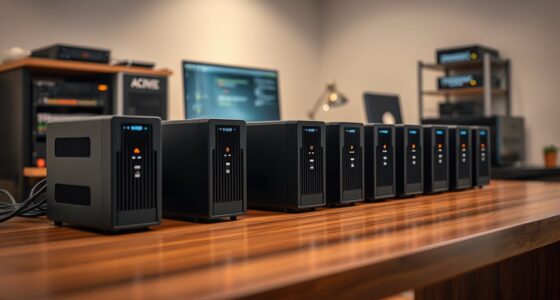If you’re looking for the best server-grade motherboards with dual 10 Gb Ethernet for high-performance networking, I’ve found top options that support robust processing power, multiple expansion slots, and enterprise-level reliability. Features like ECC memory, PCIe 4.0, and versatile storage options are common in these boards. With options tailored for servers and NAS devices, they guarantee smooth and scalable network connections. Keep exploring further, and you’ll discover how these solutions can meet your demanding needs perfectly.
Key Takeaways
- Look for motherboards with dual 10 Gb Ethernet ports based on Intel X550-T2 or similar high-speed controllers.
- Ensure compatibility with enterprise CPUs like Intel Xeon E5 or latest LGA 1700/1200 sockets.
- Check for multiple PCIe slots supporting high-speed network cards and expansion needs.
- Verify support for advanced networking features like link aggregation, Jumbo Frames, and network virtualization.
- Prioritize robust build quality, reliability, and compatibility with server-grade RAM and storage options.
MACHINIST X99 Dual CPU Motherboard for Intel Xeon & Core i7 (E-ATX, DDR4, PCIe 3.0, Dual LAN)
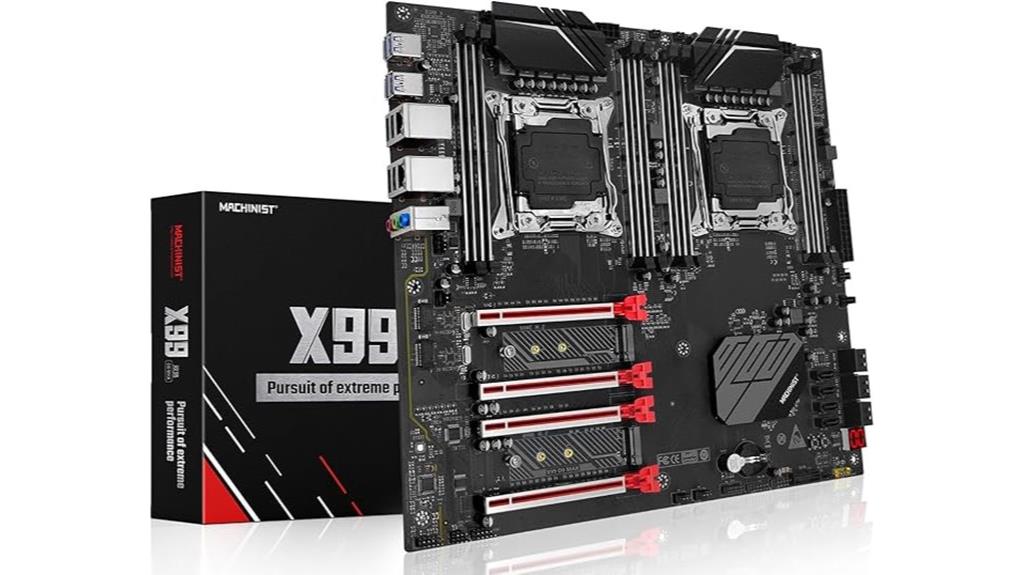
If you’re building a high-performance server or workstation that demands reliable multi-processor support, the MACHINIST X99 Dual CPU Motherboard is an excellent choice. It supports Intel 5th/6th Gen Core i7 and Xeon E5 V3/V4 processors, with dual sockets boosting performance by at least 50%. Designed as an E-ATX motherboard, it features red sockets and supports up to 256GB of DDR4 ECC memory, ideal for server applications. With four PCIe 3.0 x16 slots, dual M.2 slots, and dual LAN ports, it provides robust options for graphics and networking. Despite some limitations in expansion, it’s built for stability and high throughput.
Best For: high-performance server builders and workstation users requiring dual CPU support, extensive memory capacity, and robust graphics and networking options.
Pros:
- Supports Intel 5th/6th Gen Core i7 and Xeon E5 V3/V4 processors, enhancing processing power by at least 50%.
- Equipped with four PCIe 3.0 x16 slots and dual M.2 slots for flexible high-speed graphics and SSD configurations.
- Supports up to 256GB DDR4 ECC memory, suitable for demanding server and workstation applications.
Cons:
- Limited expansion options with no mini PCIe slots, restricting additional GPU or add-on card installations.
- Some users report BIOS quirks, memory slot instability, and hardware incompatibilities.
- Lacks official manual and comprehensive support, which can complicate troubleshooting and repairs.
X99 Dual CPU Motherboard for Intel Xeon E5 V3/V4
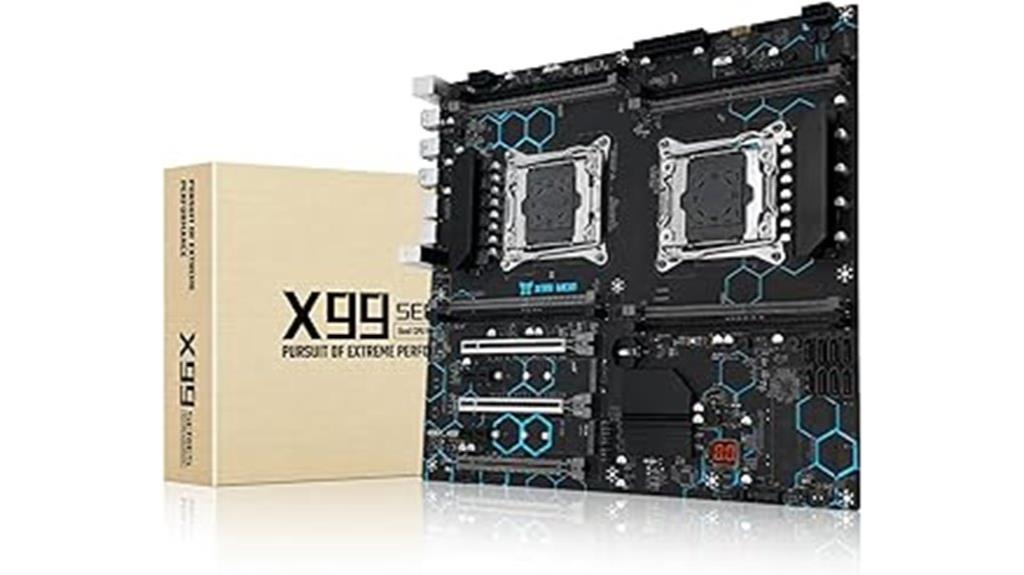
The X99 Dual CPU Motherboard is an ideal choice for professionals and enthusiasts who need maximum processing power and expandability. It supports dual Intel Xeon E5-2XXX-V3/V4 processors with the same model, using the LGA 2011-3 socket and C612 chipset. It offers up to 256GB DDR4 ECC/RECC memory across eight slots, supporting high-speed data processing. The board features multiple PCIe slots, including two PCIe 3.0 x16 and one PCIe 3.0 x8, along with dual M.2 slots for fast SSDs. Built for stability, it includes robust VRM cooling, a six-layer PCB, dual Gigabit LAN ports, and diagnostic tools for reliable high-performance networking.
Best For: professionals and enthusiasts seeking maximum processing power, expandability, and reliable high-performance networking for demanding computing tasks.
Pros:
- Supports dual Intel Xeon E5-2XXX-V3/V4 processors for exceptional multitasking and processing power
- Up to 256GB DDR4 ECC/RECC memory with high-speed support for intensive data applications
- Multiple PCIe slots and dual M.2 slots enable extensive expansion and fast SSD configurations
Cons:
- Requires server-grade RAM (ECC/RECC) which may be more expensive and less readily available than desktop RAM
- Power supply recommendations (>600W) suggest higher energy consumption and cost
- No included CR2032 battery; users must obtain it separately for BIOS/CMOS maintenance
StoneStorm W680 NAS Server Motherboard (LGA1700, DDR5, 12U-DIMM, M.2 NVMe, SATA, 10G RJ45, PCIe x16, Type-C, 8K Display)
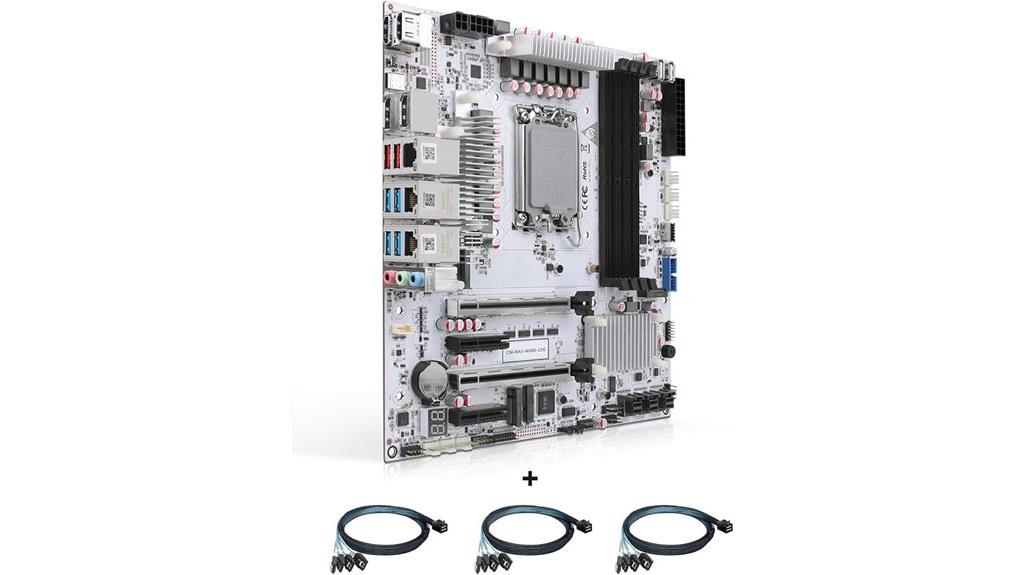
Designed for advanced NAS and server applications, the StoneStorm W680 motherboard offers a robust platform with support for LGA1700 Intel processors, DDR5 RAM, and extensive storage options. It features a compact Micro ATX form factor with 12U-DIMM slots supporting up to 128GB of non-ECC memory. The motherboard includes three M.2 NVMe slots and expands to 12 SATA ports using SFF-8643 cables, ensuring fast, reliable data transfer. Networking is highlighted by a 10GbE RJ45 port and two 2.5GbE ports, ideal for high-performance networking. Video outputs include HDMI 2.0, DisplayPort 1.4, and Type-C, supporting 8K displays for multimedia and visualization.
Best For: power users and IT professionals seeking a high-performance NAS server motherboard with extensive storage, networking, and multimedia capabilities.
Pros:
- Supports LGA1700 Intel processors with DDR5 RAM up to 128GB, ensuring future-proof performance
- Multiple high-speed storage options including 3 M.2 NVMe slots and up to 12 SATA ports for versatile data management
- Equipped with advanced networking features like 10GbE and 2.5GbE ports, plus multiple display outputs supporting 8K resolution
Cons:
- Requires dual 24PIN + 8PIN power connections and CPU 4PIN for stable operation, complicating power setup
- Micro ATX form factor may limit expansion options for larger cases or extensive hardware configurations
- First boot can take several minutes to read memory info, which may impact initial setup time
10G PCIe Network Card with Dual RJ45 Ports
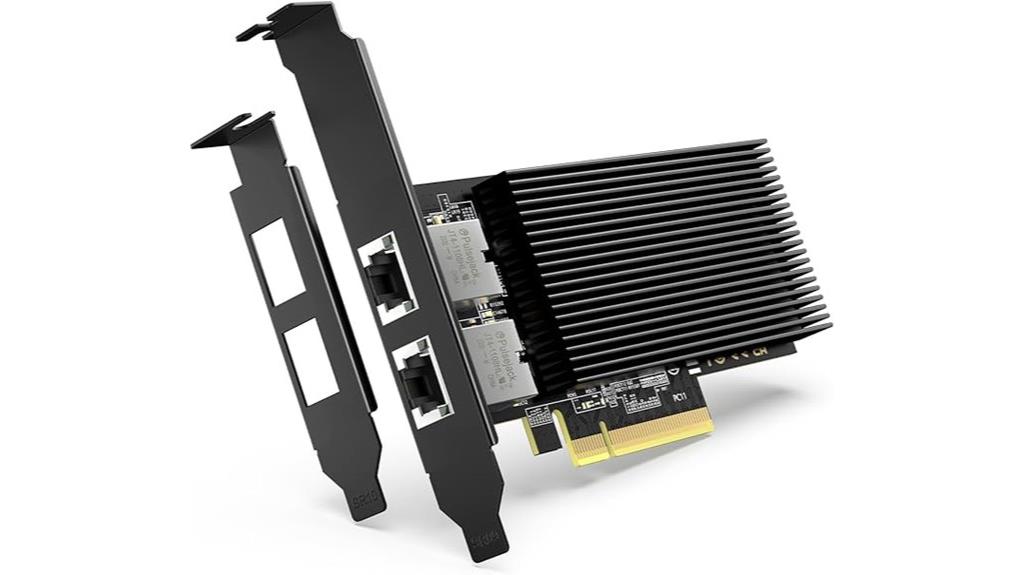
For high-performance servers and demanding network environments, the G PCIe Network Card with Dual RJ45 Ports offers a reliable solution with dual 10Gbps copper ports using the Intel X540-T2 chipset. It delivers fast, stable data transfer essential for intensive workloads. Compatibility spans Windows, Linux, VMware, and Windows Server, making it versatile across various setups. It fits PCIe x8 and x16 slots, ensuring flexible installation. The card includes a heatsink for thermal management and a gold finger interface to reduce interruptions. With standard and slim brackets available, it adapts to different server configurations, providing high-speed connectivity with minimal hassle.
Best For: high-performance servers and demanding network environments requiring reliable, high-speed data transfer with versatile compatibility.
Pros:
- Supports dual 10Gbps RJ45 copper ports with Intel X540-T2 chipset for fast data transmission
- Compatible with multiple operating systems including Windows, Linux, VMware, and Windows Server
- Flexible installation options with support for PCIe x8 and x16 slots and various bracket sizes
Cons:
- May require technical expertise for installation and configuration
- Potentially higher cost compared to lower-speed network cards
- Physical size and heat sink might not fit in very compact or specialized server cases
Gigabyte H410M H V2 Motherboard
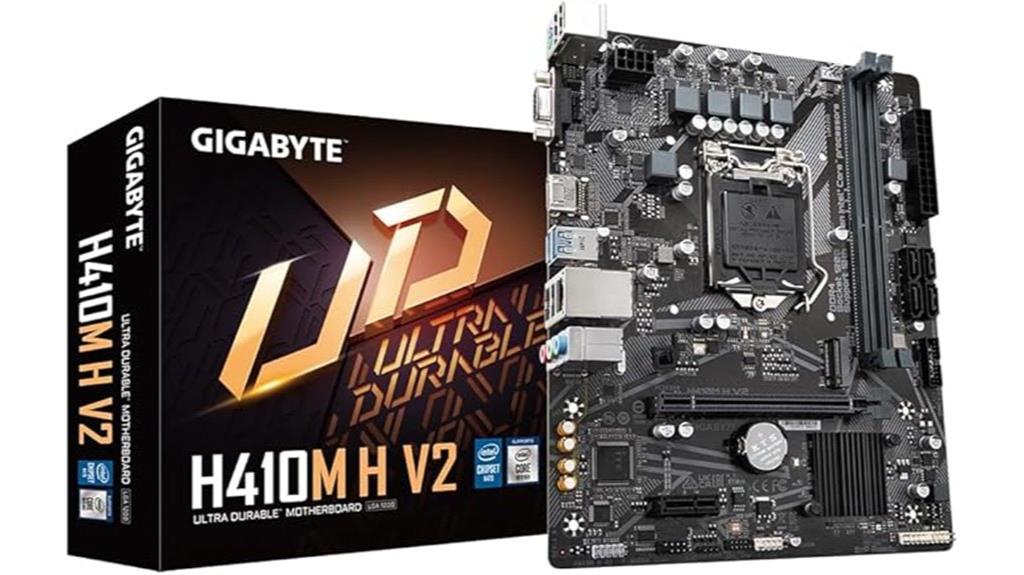
If you’re building a reliable system with 10th Gen Intel Core processors, the Gigabyte H410M H V2 Motherboard stands out because it offers robust support for high-speed DDR4 memory and NVMe SSDs. It supports dual-channel DDR4 up to 2933MHz and features an M.2 slot for PCIe Gen3 x4 NVMe drives, ensuring fast storage options. The board includes Intel GbE LAN with cFosSpeed software for optimized networking and 8-channel HD audio for quality sound. Connectivity is solid with USB 3.2 Gen 1 ports, and its smart fan and management tools make it a versatile choice for high-performance networking setups.
Best For: gamers, content creators, and users seeking a reliable motherboard for 10th Gen Intel Core processors with high-speed memory and storage options.
Pros:
- Supports high-speed DDR4 memory up to 2933MHz (OC) for improved performance
- Includes M.2 NVMe PCIe Gen3 x4 slot for fast SSD storage
- Equipped with Intel GbE LAN and 8-channel HD audio for enhanced networking and sound quality
Cons:
- Limited to 10th Gen Intel Core processors, not compatible with newer CPU generations
- Only two DDR4 DIMM slots, which may limit future memory expansion
- Lacks integrated Wi-Fi connectivity, requiring additional hardware for wireless networking
HPE ProLiant ML350 Gen11 Tower Server
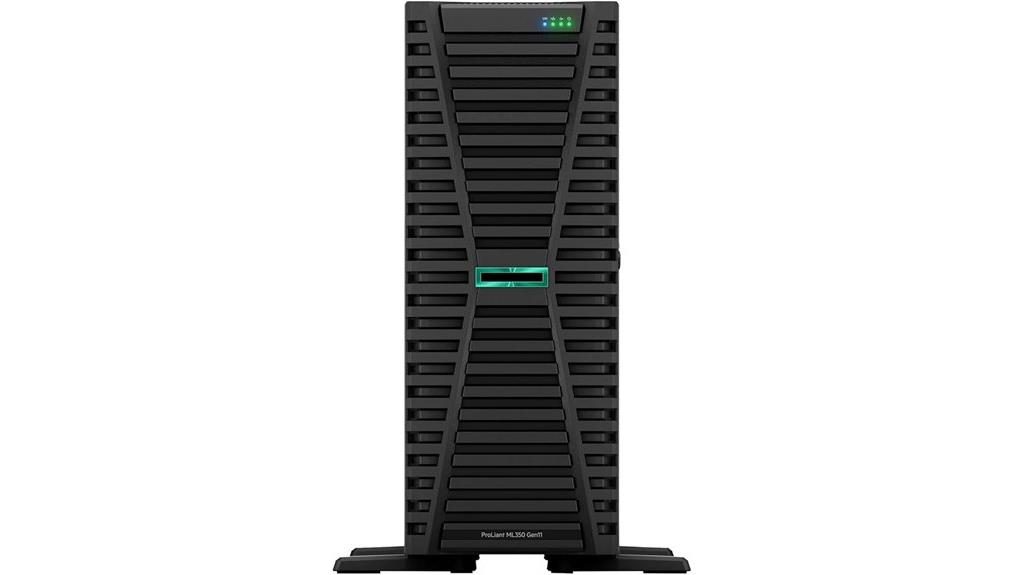
The HPE ProLiant ML350 Gen11 Tower Server stands out with its robust hardware and scalability, making it an ideal choice for organizations that need reliable, high-performance server solutions. It features dual Intel Xeon Silver 4410y processors, supporting up to 256GB of DDR5 ECC memory, and offers fast storage with 15.36TB enterprise SATA SSDs. The server includes PCIe Gen5 slots, hot-swappable redundant power supplies, and integrated 1GbE network controllers for seamless connectivity. Designed for hybrid environments, it provides remote management via iLO 6, ensuring easy setup and maintenance. Its modular, durable build makes it suitable for data centers and enterprise deployments needing scalable, secure performance.
Best For: organizations seeking a reliable, scalable, and high-performance tower server for hybrid environments, including virtualization, databases, and large-scale applications.
Pros:
- Robust hardware with dual Intel Xeon Silver 4410y processors and up to 256GB DDR5 ECC memory for high performance
- Flexible storage options with 15.36TB enterprise SATA SSDs and PCIe Gen5 support for fast data transfer
- Easy remote management via integrated iLO 6 and hot-swappable redundant power supplies for simplified maintenance
Cons:
- May be bulky and require significant space in data center environments
- Upgrading drives and memory requires separate installation and setup
- Higher initial investment cost compared to entry-level servers
HPE ProLiant ML350 Gen11 Tower Server Bundle

The HPE ProLiant ML350 Gen11 Tower Server Bundle stands out as an excellent choice for organizations that require robust, server-grade motherboards capable of handling demanding workloads. It features a 4U tower form factor optimized for hybrid environments, offering intuitive operation, strong security, and high performance for virtualization. Equipped with dual Intel Xeon Silver 4410y processors, it delivers 24 cores and turbo speeds up to 3.90 GHz. With 512GB DDR5 ECC memory and 15.36TB of fast SSD storage, it ensures reliable, high-speed data processing. Additional features like dual power supplies, iLO management, and flexible upgrade options make this bundle ideal for high-performance networking needs.
Best For: organizations requiring a high-performance, scalable server solution optimized for virtualization, data processing, and hybrid cloud environments.
Pros:
- Powerful dual Intel Xeon Silver 4410y processors with 24 cores for demanding workloads
- Large 512GB DDR5 ECC memory for high-speed, reliable data processing
- Fast 15.36TB SSD storage in RAID configuration for efficient data access and storage
Cons:
- Memory and storage upgrades sold separately, requiring additional installation effort
- Heavy 4U tower form factor may require significant physical space and setup considerations
- Comes with a license for Windows Server 2022 Standard, additional licensing costs may apply for other software needs
10Gb PCI-E Network Card for Intel X550-T2

A Gb PCI-E Network Card for Intel X550-T2 stands out as an ideal choice for high-performance enterprise environments that demand reliable, scalable network connectivity. It features dual RJ45 ports based on the Intel X550 controller, supporting auto-negotiation between 100MbE, 1GbE, and 10GbE for seamless network upgrades. Compatible with Windows, Linux, FreeBSD, VMware, and more, it offers broad OS support. With advanced features like PCI-SIG SR-IOV, VMDq, and jumbo frames, it ensures smooth, efficient operation. Easy to install with both low-profile and full-height brackets, this card is perfect for modern servers needing robust 10 Gb Ethernet connectivity.
Best For: high-performance enterprise servers and data centers seeking scalable, reliable 10Gb Ethernet connectivity.
Pros:
- Supports auto-negotiation between 100MbE, 1GbE, and 10GbE for flexible network upgrades
- Compatible with a wide range of operating systems including Windows, Linux, FreeBSD, and VMware
- Features advanced technologies like PCI-SIG SR-IOV, VMDq, and Jumbo Frames for efficient network performance
Cons:
- Requires PCIe v3.0 x4 slot, which may not be available in all systems
- Installation may necessitate driver setup from CD or official website, potentially adding complexity for some users
- Limited to specific model (Intel X550-T2), which may restrict compatibility with other network hardware
ASUS Micro-ATX Motherboard (Intel H510 LGA 1200)
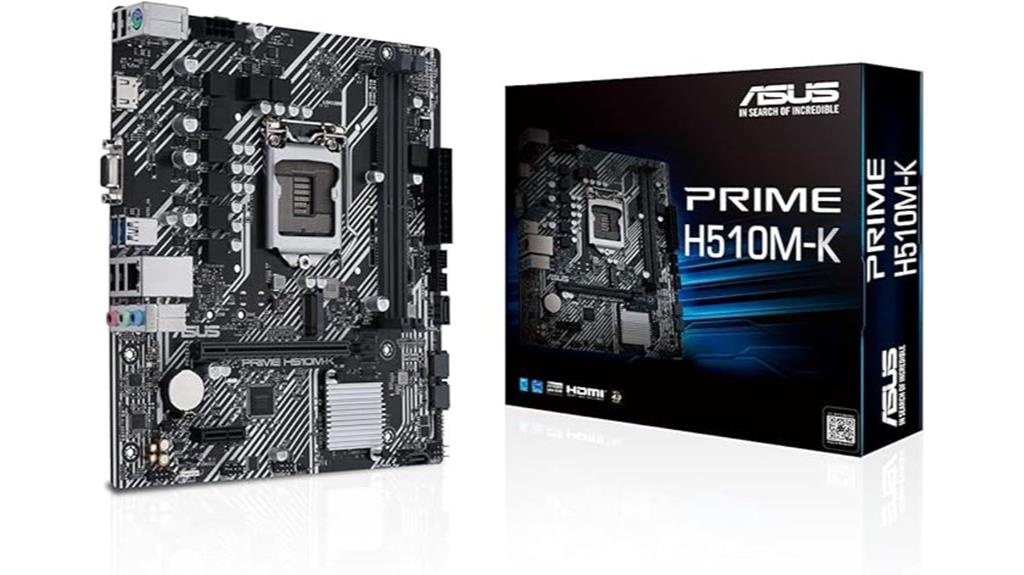
If you’re building a compact yet powerful system with reliable connectivity, the ASUS Micro-ATX Motherboard (Intel H510 LGA 1200) is an excellent option. It supports 11th Gen Intel Core processors with the LGA 1200 socket and offers PCIe 4.0 for fast data transfer. The motherboard features a 32Gbps M.2 slot for NVMe SSDs, an Intel 1Gb Ethernet port, and USB 3.2 Gen 1 Type-A for peripherals. It includes HDMI and D-Sub outputs, SATA ports, RGB lighting, and a COM port. Designed for reliability, it also has cooling solutions and hardware security features, making it suitable for versatile, high-performance builds.
Best For: users seeking a compact, reliable motherboard with high-speed connectivity and expandability for versatile high-performance builds.
Pros:
- Supports 11th Gen Intel Core processors with LGA 1200 socket for up-to-date performance
- PCIe 4.0 support enables fast data transfer for compatible devices
- Multiple connectivity options including M.2 NVMe slot, USB 3.2 Gen 1, HDMI, D-Sub, and Ethernet
Cons:
- Compatibility of RAM and processor must be verified on the manufacturer’s website before purchase
- Limited to Micro-ATX form factor, which may restrict expansion options compared to larger boards
- Does not include integrated Wi-Fi, requiring an additional network card for wireless connectivity
HPE ProLiant ML350 Gen11 Tower Server Bundled with Dual Xeon 4410y, 256GB DDR5, 15.36TB SAS SSD, RAID, Dual Power, iLO & Windows Server 2022
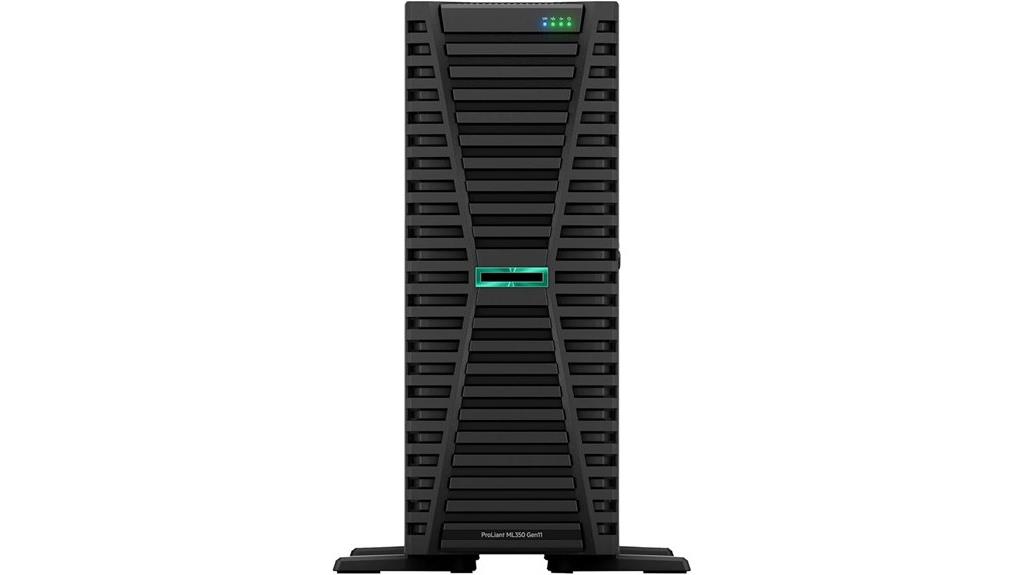
Are you seeking a powerful, reliable server built to handle demanding workloads like virtualization and large databases? The HPE ProLiant ML350 Gen11 is a versatile tower server designed for hybrid environments. It features dual Intel Xeon Silver 4410y processors, 256GB DDR5 memory, and 15.36TB SAS SSD storage, supporting high-speed data transfer with PCIe Gen5. Redundant power supplies guarantee uptime, while integrated iLO 6 offers remote management. Preloaded with Windows Server 2022, it combines security, scalability, and ease of use. This server is ideal for enterprise and small business applications requiring robust performance, storage, and manageability in a compact, well-designed chassis.
Best For: small to large enterprises and IT professionals seeking a high-performance, scalable tower server for virtualization, databases, and large-scale applications.
Pros:
- Robust dual Intel Xeon Silver 4410y processors deliver powerful multi-core performance
- Large 256GB DDR5 memory and 15.36TB SAS SSD storage support demanding workloads and fast data access
- Redundant power supplies and hot-swappable components ensure high availability and minimal downtime
Cons:
- Initial setup and upgrades require technical expertise and may involve additional costs for hardware installation
- The size and weight (26 x 10 x 20 inches, 54 pounds) may require dedicated space and proper handling
- Being a high-end enterprise server, it may be overkill and less cost-effective for small or less demanding environments
StoneStorm W680 NAS Server Motherboard (LGA1700, DDR5, M.2, SATA, 10G RJ45, PCIe, Type-C, 8K Display)
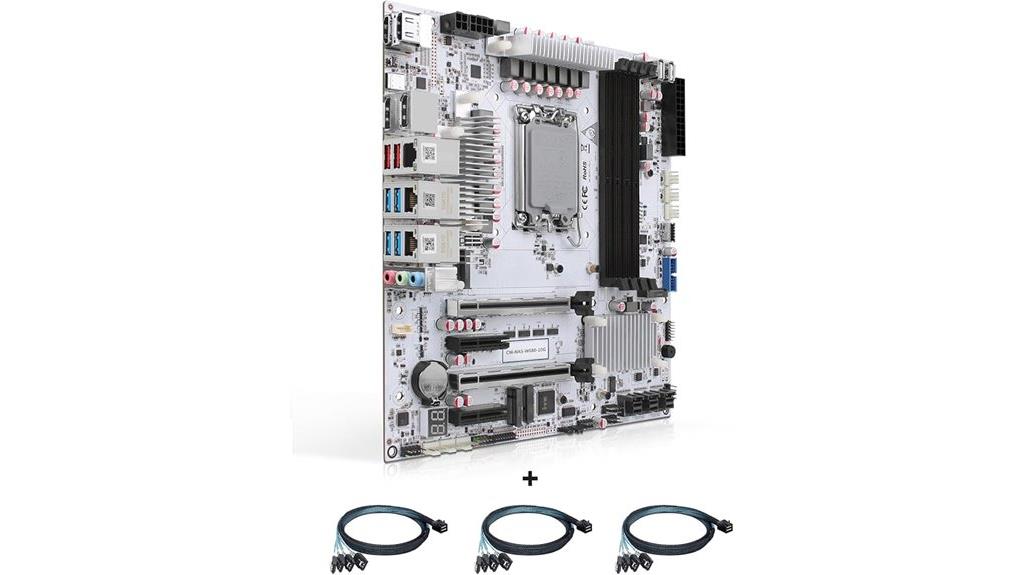
The StoneStorm W680 NAS Server Motherboard stands out as an ideal choice for professionals seeking a compact yet powerful server solution, thanks to its Micro ATX design and extensive connectivity options. It supports LGA1700 processors, including Intel’s latest 12th to 14th Gen CPUs, with up to 128GB DDR5 RAM for fast, efficient multitasking. Equipped with three M.2 slots, 12 SATA ports, and dual 10GbE plus two 2.5GbE network interfaces, it handles high-speed data transfer and network demands. Video output options include HDMI2.0, DisplayPort1.4, and Type-C, supporting 8K displays. Overall, it’s a versatile, energy-efficient motherboard perfect for NAS and high-performance server setups.
Best For: professionals and enthusiasts seeking a compact, high-performance NAS or server solution with versatile connectivity and support for the latest CPUs and high-speed networking.
Pros:
- Supports LGA1700 Intel 12th to 14th Gen CPUs and up to 128GB DDR5 RAM for powerful multitasking.
- Multiple high-speed network interfaces including 10GbE and 2.5GbE ports for fast data transfer.
- Rich video output options (HDMI2.0, DisplayPort1.4, Type-C) supporting 8K displays and multimedia applications.
Cons:
- Requires dual 24PIN + 8PIN power connections plus CPU 4PIN for optimal stability.
- First boot may take several minutes to read memory info, which could delay setup.
- Compatibility with certain cooling solutions or additional accessories may require specific components or BIOS adjustments.
10Gb PCIe Network Card with Dual RJ45 Ports and Intel X550-AT2 Controller
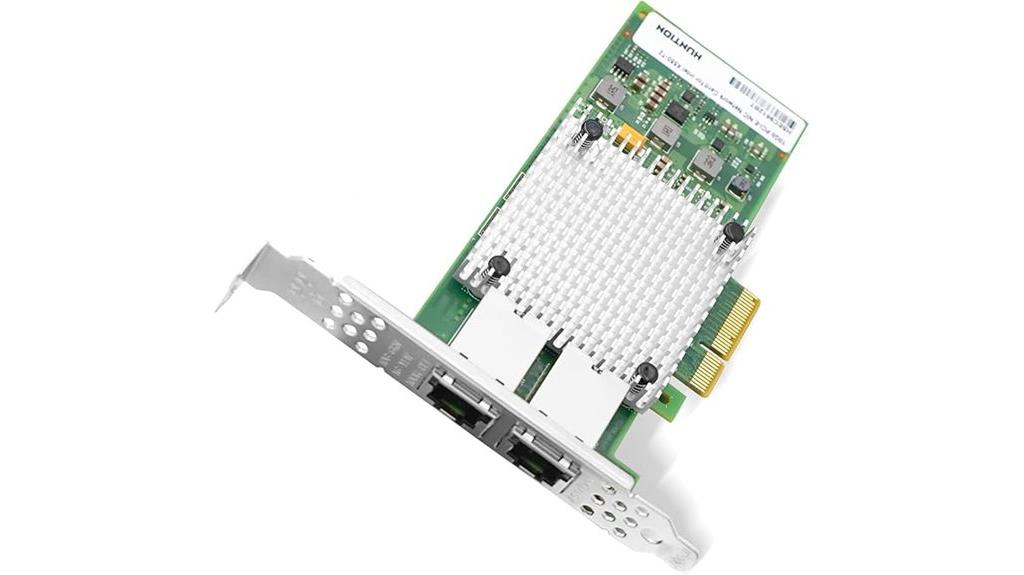
For those building high-performance servers or workstations, the Gb PCIe Network Card with Dual RJ45 Ports and Intel X550-AT2 Controller stands out as an ideal choice, especially when reliable, high-speed wired connectivity is essential. This card offers dual 10GbE ports supporting auto-negotiation with 1GbE and 100MbE, ensuring versatile network compatibility. It fits PCIe v3.0 x4 slots and includes low-profile and full-height brackets, making it suitable for various systems. Designed for stability, it delivers nearly 10Gbps throughput, with support for multiple operating systems and advanced features like Jumbo Frames and SR-IOV. Installation is straightforward, and it’s praised for consistent, high-speed performance.
Best For: professionals and enthusiasts needing reliable, high-speed wired networking for servers, workstations, or data-intensive applications.
Pros:
- Delivers nearly 10Gbps throughput with stable, high-speed performance.
- Compatible with a wide range of operating systems including Windows, Linux, and VMware.
- Supports advanced features like Jumbo Frames, SR-IOV, and VMDq for optimized network efficiency.
Cons:
- Runs hot; may require good airflow or thermal management.
- Initial driver setup can be complex, sometimes needing manual installation or updates.
- Some users report compatibility issues or limited aesthetic appeal despite full functionality.
ASUS Prime H510M-E Micro-ATX Motherboard
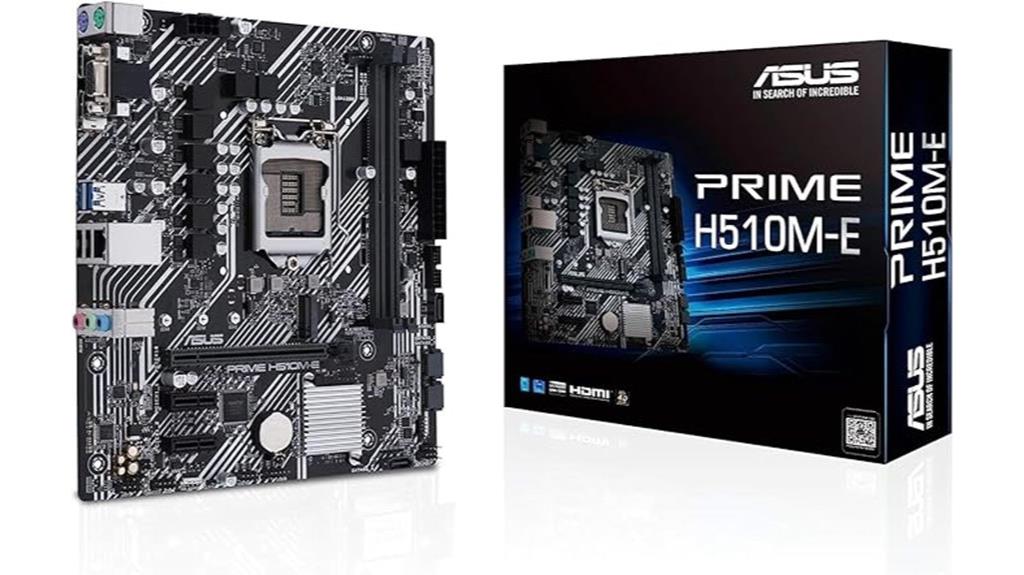
If you’re building a reliable, budget-friendly system that supports 11th and 10th Gen Intel Core processors, the ASUS Prime H510M-E Micro-ATX motherboard is an excellent choice. It offers solid compatibility with Intel LGA 1200 sockets and features PCIe 4.0, a 32Gbps M.2 slot, and Intel 1Gb Ethernet for dependable connectivity. Designed with ASUS OptiMem for better memory performance and equipped with detailed cooling solutions, it guarantees stability. While it lacks USB-C and native RGB support, it’s praised for easy installation, reliable operation, and compatibility with popular CPUs and GPUs. It’s a practical, value-oriented option for everyday and DIY builds.
Best For: budget-conscious DIY builders and daily users seeking reliable performance with 10th and 11th Gen Intel CPUs.
Pros:
- Supports PCIe 4.0 and fast M.2 storage for improved performance
- Easy installation with detailed manuals and stable Windows 11 compatibility
- Robust protection features like 5X Protection III for durability
Cons:
- Lacks native USB-C (USB 3.2) port, limiting modern device connectivity
- Limited RGB fan compatibility and requires adapters for RGB systems
- No built-in Wi-Fi, which might require additional expansion options
Factors to Consider When Choosing a Server‑Grade Motherboard With Dual 10 Gb
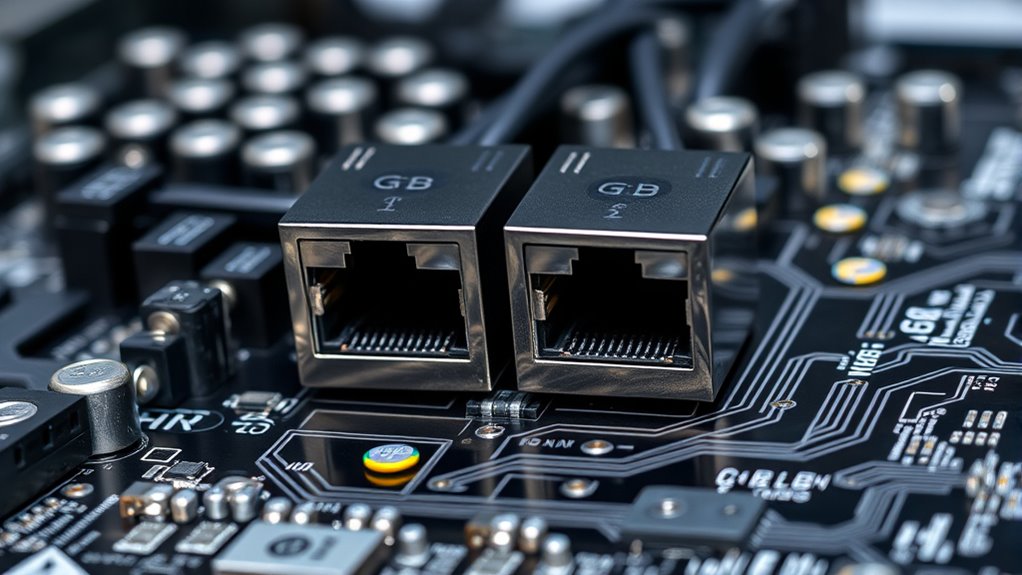
When selecting a server-grade motherboard with dual 10 Gb ports, I focus on compatibility with CPUs to guarantee ideal performance. I also consider network interface options, expansion slots, memory support, and power supply needs to match my specific requirements. These factors help me choose a reliable and scalable platform that meets my workload demands.
Compatibility With CPUS
Choosing a server-grade motherboard with dual 10 Gb ports demands careful attention to CPU compatibility to guarantee peak performance and system stability. First, verify the motherboard supports the specific CPU socket type your processors require, such as LGA 2011-3 or LGA 1700. Compatibility between the motherboard’s chipset and your processor series, like C612 for Xeon E5 V3/V4 or Intel 600 series for newer CPUs, is essential. You also need to ascertain that the motherboard can handle the CPU’s power demands, including support for ECC memory if you’re using Xeon processors. Additionally, check that the BIOS or firmware version supports your chosen CPU models, especially for recent or high-performance chips. Finally, confirm the motherboard’s VRM and thermal design can accommodate the TDP and performance needs of both CPUs.
Network Interface Options
High-speed data transfer capabilities are essential in enterprise servers and data centers, making dual 10 Gb network interfaces a popular choice. When selecting a motherboard, I consider compatibility with PCIe x8 or x16 slots to guarantee the NICs perform at peak bandwidth. Advanced servers often feature multi-port configurations, link aggregation, and support for legacy Ethernet standards, enhancing flexibility. I also look for NIC features like SR-IOV, Jumbo Frame support, and network virtualization, which boost performance and scalability. Multi-gigabit ports, such as 1GbE or 2.5GbE, offer upgrade paths and diverse connectivity options. These factors help create a robust, high-performance networking infrastructure capable of handling demanding workloads while future-proofing and expandability.
Expansion Slot Availability
To guarantee your server motherboard can handle multiple high-performance components, it’s essential to verify the availability and configuration of its PCIe slots. Make sure there are enough slots, like x8 or x16, to support multiple network cards, GPUs, or storage expansion cards. Check the PCIe slot version—3.0 or 4.0—to ensure it meets your bandwidth needs for high-speed network cards and peripherals. Pay attention to the physical spacing and form factor of the slots to accommodate larger cards without conflicts. Additionally, confirm support for secondary expansion slots such as M.2 or U.2 for NVMe storage options alongside your network hardware. Finally, review the motherboard’s documentation to understand the maximum number of PCIe lanes, ensuring sufficient bandwidth for all installed components.
Memory Support and Speed
When selecting a server-grade motherboard with dual 10 Gb Ethernet, it’s important to guarantee compatibility with high-speed memory modules like DDR4 or DDR5. These motherboards typically support up to 256GB or more per CPU socket, enabling substantial memory capacity. Memory speeds vary from 2133MHz to over 4000MHz, with overclockable options available for enhanced performance. Support for ECC memory is standard, ensuring data integrity and stability indispensable in server environments. To maximize bandwidth and stability, ideal configurations involve populating multiple channels—such as quad-channel—with matching modules. However, it’s necessary to verify the motherboard’s official specifications to ensure compatibility with specific memory speeds and types, preventing potential instability or hardware conflicts. Proper memory support is key for high-performance, reliable networking.
Power Supply Requirements
Choosing the right power supply for a server-grade motherboard with dual 10 Gb Ethernet ports is essential to guarantee stable and reliable operation. These motherboards typically need high-wattage power supplies, often 600W or more, to support multiple high-speed network cards and demanding components. They usually require dedicated connectors like 24-pin ATX, 8-pin CPU, and sometimes additional 4-pin or 8-pin connectors for stability. Ensuring the power supply has sufficient PCIe connectors, such as 6+2 pin, is fundamental for powering dual 10 Gb Ethernet cards and high-performance CPUs. Additionally, the power supply should offer high-quality, stable voltage regulation and adequate amperage on the 12V rail to handle peak loads. Compatibility with the motherboard’s form factor and connectors is also essential for proper installation and reliable performance.
Cooling and Thermal Design
Effective cooling is essential for server-grade motherboards equipped with dual 10 Gb Ethernet ports because high-performance components generate significant heat that can impact stability and lifespan. To manage this, look for motherboards with multiple fan headers, VRM heatsinks, and chipset heatsinks that help dissipate heat efficiently. Proper airflow within the chassis is crucial, so pay attention to fan placement and case venting to prevent hotspots around NICs and power modules. Using high-quality thermal interface materials and large heatsinks ensures stable temperatures under heavy workloads. Incorporating temperature sensors and monitoring systems allows for real-time fan adjustments, optimizing cooling and reducing noise and energy use. Additionally, ensuring sufficient space and airflow clearance around the motherboard and expansion cards is vital for maintaining consistent performance.
Future Upgrade Potential
Selecting a server-grade motherboard with dual 10 Gb Ethernet involves more than just current features; it’s about anticipating future needs. I look at PCIe slot availability and configuration to guarantee I can add high-speed network cards or peripherals later. Compatibility with upcoming processor generations is essential, so I check the chipset and CPU socket for future upgrades without replacing the motherboard. I also evaluate support for higher RAM speeds, increased capacity, and ECC features to future-proof memory upgrades. BIOS and firmware update policies matter too, as they impact security and compatibility improvements over time. Finally, I guarantee the power delivery system and cooling infrastructure are robust enough to handle hardware enhancements and workload demands down the line. Future-proofing helps maximize my investment and keeps my system adaptable.
Frequently Asked Questions
What Are the Compatibility Requirements for Dual 10 Gb Ethernet Motherboards?
To guarantee compatibility, I check that the motherboard has the right PCIe slots for dual 10 Gb Ethernet cards. I also verify that the motherboard’s chipset supports these cards and that the BIOS is updated. Additionally, I confirm the power supply can handle the extra network hardware. Compatibility with my operating system and drivers is vital, too, to ensure smooth performance and seamless integration.
How Does PCIE Version Affect Network Performance on These Motherboards?
Did you know that PCIe 4.0 doubles bandwidth compared to PCIe 3.0? It considerably impacts network performance on motherboards with dual 10 Gb Ethernet. Higher PCIe versions offer faster data transfer, reducing bottlenecks and ensuring smoother, more efficient networking. When choosing a motherboard, I always look for the latest PCIe support, as it guarantees better throughput and future-proofing for high-performance networking setups.
Can These Motherboards Support Virtualization Workloads Effectively?
Yes, these motherboards support virtualization workloads effectively. I’ve found that their robust CPU support, large memory capacities, and multiple PCIe slots enable smooth VM operation and high-density environments. The dual 10 Gb Ethernet ensures fast, reliable network connectivity, which is vital for virtualization tasks. Plus, server-grade features like hardware-assisted virtualization (Intel VT-x or AMD-V) help optimize performance, making them ideal for demanding virtualization workloads.
What Are the Power Consumption Considerations for High-Performance Networking Motherboards?
Power consumption matters a lot when choosing high-performance networking motherboards. I look for boards with energy-efficient components, low idle power, and good thermal management. Dual 10 Gb Ethernet ports can increase power draw, so I prioritize models with advanced power regulation and efficient VRMs. I also consider the overall system’s power supply capacity and cooling solutions to avoid overheating and guarantee stable, efficient operation during intensive workloads.
How Do Firmware and BIOS Updates Impact Network Stability and Security?
Firmware and BIOS updates greatly impact network stability and security by fixing bugs, patching vulnerabilities, and improving hardware compatibility. I always keep mine up to date to ensure my networking setup remains secure against threats and runs smoothly. Skipping updates can leave me exposed to security risks or cause little glitches that disrupt high-performance data transfer. Regular updates are essential for maintaining a reliable, secure, and efficient network system.
Conclusion
Choosing the right server-grade motherboard with dual 10 Gb Ethernet can greatly boost your network performance. Did you know that businesses upgrading to 10 Gb Ethernet see an average data transfer increase of 10x? With options like the MACHINIST X99 or StoneStorm W680, you can future-proof your setup and handle demanding workloads with ease. Investing in quality hardware now guarantees smoother, faster, and more reliable networking down the line.



